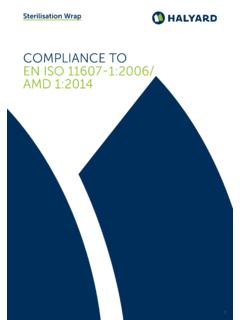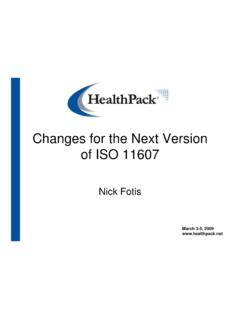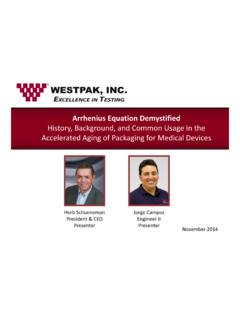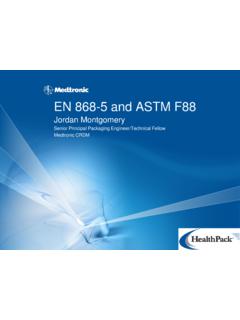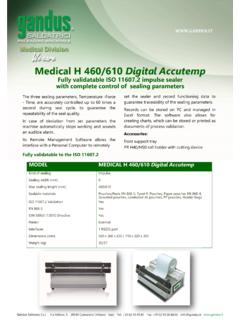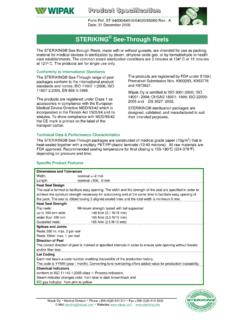Transcription of Packaging Validation according to ISO 11607 - …
1 Synergy makes sence Packaging Validation according to ISO 11607 . MG-FSI72-104. Last revision: March 2011. 5, Chemin du Catupolan - 69120 Vaulx en Velin - France - Tel. 33 (0)4 72 81 22 62 - Fax : 33 (0)4 72 81 22 72. MEDICAL LAB. Established in 1989, MedicalGroup presently has five subsidiary companies specialising in the biomedical field: MedicalCoating, MedicalPackaging, MedicalBiomat, MedicalManufacturing and MedicalLab. All of these organisations are EN ISO 13485 certified. Medical Lab offers a comprehensive Performance Qualification service for medical devices: coating, cleaning, Packaging and sterilisation validations. The purpose of these qualifications is to assure clients that their medical devices comply with European (EC) and US (FDA) regulations. THE VARIOUS TYPES OF Packaging . Extract from the introduction of ISO 11607 -1: 2006. The objective of a Packaging system for terminally sterilised medical devices is to enable the sterilisation, physical protection and preservation of sterility up to the point of use and to provide an aseptic presentation.
2 The sterile barrier system is essential for the safety of terminally sterilised medical devices. COMPONENTS. Several types of Packaging components can be used for holding medical devices so that the integrity of the sterile barrier is preserved and they can be easily handled in the operation room. Single or double Packaging can be used, depending on the type and shape of the products, and the geometry of the Packaging . The Packaging can be presented as pouches or blister packs. All of the Packaging components for the device must be non-reusable. The device's Packaging guarantees sterility throughout the storage life specified on the labelling under normal conditions of storage and transport. Validation for the devices should be performed. MATERIALS. There are two types of Packaging materials: - gas-porous materials ( : Tyvek ). For these materials, the microorganism barrier properties shall be validated. - Waterproof materials. SEALING. The Packaging components are sealed.
3 The sealing parameters to be tested are usually: - sealing temperature - sealing time - sealing pressure. STANDARDS AND REGULATIONS. ISO 11607 -1 (2006) Packaging for terminally sterilized medical devices Part 1: Requirements for materials, sterile barrier systems and Packaging systems ISO 11607 -2 (2006) Packaging for terminally sterilized medical devices Part 2: Validation requirements for forming, sealing and assembly processes Test methods standards listed in ISO 11607 -1: 2006 Annex B. IQ, OQ and PQ Validation . In order to guarantee reproducibility of the Packaging system, the sealing processes must be IQ, OQ and PQ validated Installation Qualification (IQ). Tests and checks are performed on the processes to verify that their characteristics meet previously established specifications. Operational Qualification (OQ). After setting the standard adjustment parameters for obtaining a sample result meeting the specifications, the OQ enables Validation of these standard parameters, even when the process is carried out under worst case conditions.
4 Performance Qualification (PQ). This part of the Validation serves to demonstrate that the system yields a reproducible, correct result on the product. The PQ is therefore conducted in two phases: Process PQ: carried out by the Packaging service provider. This determines the long-term reproducibility of the process. Product PQ: carried out under the supervision of the product manufacturer. This determines compliance of the result of the Packaging process on the product. Packaging PERFORMANCE QUALIFICATION. Performance qualification of the Packaging validates the interaction between the medical device, the Packaging , the sterilisation process and the impact of the storage time up to the expiry date. For Packaging Validation , MedicalLab follows the protocol bellow: 1) Defining the product families based on the geometry of the pieces, the Packaging and the sterilisation method. 2) Defining the product representing each family. 3) Determining the sampling method for each test to be conducted 4) Sterilising the products under critical conditions (for example, for routine gamma sterilisation at 25-40 kGy, the samples are to be irradiated at 40-50 kGy).
5 5) Performing accelerated aging on the samples to validate the expiry date (simultaneously producing a set of samples to be allowed to age in real time). 6) Conducting an ISTA transport test 7) Conducting all characterisation tests necessary to assess the microbial barrier of the Packaging system THE VARIOUS TYPES OF TESTS PERFORMED BY MEDICAL LAB. 1. MICROBIAL BARRIER TEST. Reference standard: ASTM F 1608 Standard test method for microbial ranking of porous Packaging materials (Exposure chamber method). The aim of this test is to assess the microbial barrier of porous Packaging materials. Test samples are placed in an exposure chamber and an aerosol of Bacillus atrophaeus spores is applied in the chamber. Spores which passed through the test sample are collected on membranes filter and enumerated. 2. TOLUIDINE BLUE TEST. Reference standard: ASTM F 1929 Standard test method for detecting seal leaks in porous medical Packaging by dye penetration The aim of this test is to assess the sealing tightness.
6 A dye penetrant is injected into the package to cover all the sealings; the contact is maintained for 5 to 20 seconds. Then, a visual exam of the sealing area through the transparent side of the package is carried out. 3. VISUAL INSPECTION TEST. Reference standard: ASTM F 1886 Standard test method for determining integrity of seals for medical Packaging by visual inspection The aim of this test is to assess the sealing tightness. A visual exam at a distance of 30 to 45 cm is carried out to inspect the entire sealed area of the Packaging for completeness and uniformity. The defects (number and location) are identified and recorded. Example of defects: unsealed areas, nonhomogeneous area, channels 4. IMMERSION TEST. Reference standard: MedicalLab Protocol ML-FSI82-006. The aim of this test is to assess the tightness of the whole Packaging . The sample is placed in a container filled with water at a depth greater than 150 mm and is maintained for 20 seconds. Then, it is verified that no air bubbles escape from the sealing or the Packaging .
7 5. PEALABILITY TEST (Manual). Reference standard: NF EN 868-5 Packaging for terminally medical devices . Part 5 Sealable pouches and reels of porous materials and plastic film construction . Requirements and test methods Appendix E. The aim of this test is to assess the pealing ability of the Packaging . The package is peeled slowly and carefully and the seal on the entire width and length is verified. The width of the sealing area is measured. 6. PEALABILITY TEST (With tensile strength equipment). Reference standard: French pharmacopoeia The aim of this test is to assess the pealing ability of the Packaging . Samples are cut of 15 mm width and placed in the tensile testing machine. The maximum pealing strength is measured. 2. 1. 3. 7. SEALING STRENGTH TEST. Reference standard: ASTM F 88 Standard test method for sealing strength of flexible barrier materials NF EN 868-5 Packaging for terminally medical devices Part 5 Sealable pouches and reels of porous materials and plastic film construction Requirements and test methods Appendix D.
8 The aim of this test is to assess the strength of the sealing. The samples are cut of 15 mm width and placed in the tensile testing machine. The maximum strength is measured. 4 2. 1. 5 3. 8. VACUUM TEST. Reference standard: MedicalLab Protocol The aim of this test is to assess level of the vacuum in vacuum pouches. The sample is placed in a vacuum-bell jar linked with a pressure gauge and a low vacuum pump. The vacuum (pressure in mbar) in the pouch is quantified. 9. ACCELERATED AGING. Reference standard: ASTM F 1980 Standard guide for accelerated aging of sterile barrier systems for medical devices The aim of this test is to simulate the aging of the Packaging up to the expiry date. The Packaging samples are placed in the thermo-regulated chamber at 55 C for accelerated aging. During the whole aging time, temperature of the chamber is monitored. After aging, the packagings are tested. ? DESIGN: QUESTIONS TO ASK. What are the guidelines and recognized standards in the countries targeted for product sales?
9 What is the list of required tests for my Packaging qualification dossier? Does my Packaging service supplier have a process Validation IQ, OQ, Process-PQ on which I. can draw on? What are my product families? What sampling method should I choose for my Packaging qualification? What type of microbial barrier does the Packaging have (airtight or porous)? What type of physical barrier does the Packaging have? Isn't the medical device liable to penetrate the Packaging if it falls or due to transport vibrations? Is the Packaging material non toxic after sterilization? Is the Packaging material compatible with sealing process? Is the Packaging material compatible with sterilization process? Is the Packaging compatible with shelf life of the medical device? Is the Packaging compatible with the labelling process? REASONS FOR CHOOSING MEDICAL LAB. Acknowledged expertise in medical device testing, and French, European, Chinese and US. standards and regulations A full service partner offering training, consultancy and testing services An efficient ISO 13485:2003 quality control system ISO 17025 contamination and sterility tests A multilingual sales team (English, German, Italian, Spanish, Arabic, Chinese ).
10 Our experts can assist you with your regulatory processes, and help you determine Validation protocols Our collaborative interaction with the MEDICAL GROUP helps you limit your suppliers, save time in having your batches released and reduce your transport costs Speedy communication of results (by e-mail or on the website). CONTACTS. Aur lien BIGNON. MedicalLab General Manager St phane PLET Alice MARTINHO R gine GRIES. Manager of Manager of Quality Control Director physico-chemical department microbiological and Packaging test department OUR SALES TEAM. Alain BRUNEL. Sales Manager Rachid ZEROUALI Richard PUZENAT. Export Sales Manager Sales Manager (France). MedicalLab MedicalGroup World Wide 5, Chemin du Catupolan - 69120 Vaulx en Velin - France - Tel. 33 (0)4 72 81 22 62 - Fax : 33 (0)4 72 81 22 72.

